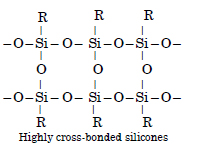Question 1:
What are the common physical and chemical features of alkali metals ?
Answer:
Refer to Basis and Basics.
Question 2:
Discuss the general characteristics and gradation in properties of alkaline earth metal.
Answer:
Refer to Basis and Basics.
Question 3:
Why are alkali metals not found in nature ?
Answer:
Alkali metals are highly reactive due to
(i) low ionisation enthalpy and
(ii) strong electropositive character. Therefore, they do not occur in free or native state and always occur in the combined state. As a result, alkali metals are not generally found in nature.
Question 4:
Find the oxidation state of sodium in Na2O2.
Answer:
Let oxidation state of Na = x
2x + 2 (– 1) = 0 or x = + 1
Question 5:
Explain why is sodium less reactive than potassium.
Answer:
This is mainly due to high ionisation enthalpy of sodium as compared to potassium. Therefore, the potassium is more electropositive and stronger reducing agent than sodium. It also reacts with water more violently than sodium.
Question 6:
Compare the alkali metals and alkaline earth metals with respect to :
(i) ionisation enthalpy
(ii) basicity of oxides
(iii) solubility of hydroxides.
Answer:
(i) Ionisation enthalpy. The ionisation enthalpy of alkaline earth metal (group 2) is more as compared to alkali metal (group 1) present in the same period due to smaller size and more symmetrical configuration.

(ii) Basicity of oxides. Oxides of alkali metals are stronger bases as compared to those of alkaline earth metals present in the same period. This is quite evident from the fact that when Na2O is dissolved in water, NaOH formed is a stronger base than when MgO is dissolved in water to form Mg(OH)2. This is due to higher ionisation energies.Group 1 elements have lower ionisation energies than group 2 elements. Hence hydroxides of group 1 elements are stronger bases as compared to hydroxides of group 2 elements.
(iii) Solubility of hydroxides. Alkali metal hydroxides are more soluble in water as compared to the hydroxides of alkaline earth metals present in the same period. This is because of higher lattice energy of the hydroxides of alkaline earth elements
as compared to those of alkali metals.
Question 7:
In what ways lithium shows similarity to magnesium in its chemical behaviour ?
Answer:
(i) Both are hard.
(ii) Both have high melting points.
(iii) Both have a tendency to form covalent compounds.
(iv) Both react slowly with water.
Question 8:
Explain why alkali and alkaline earth metals cannot be obtained by chemical reduction.
Answer:
The metals belonging to both these families are very strong reducing agents. It is, therefore not possible to reduce their oxides by reacting with common reducing agents such as carbon (coke), zinc etc. These are generally obtained by the electrolysis of their molten halides.
Question 9:
Why are potassium and cesium, rather than lithium used in photoelectric cells ?
Answer:
This is because K and Cs have high ionisation energies.
Question 10:
When an alkali metal is dissolved in liquid ammonia, the solution can acquire different colours. Explain the reason for this type of colour change.
Answer:
Refer to Basis and Basics. (Section 10.2)
Question 11:
Beryllium and magnesium donot give colour to the flame while other alkaline earth metals do so. Explain.
Answer:
Refer to Basis and Basics.
Question 12:
Potassium carbonate cannot be prepared by Solvay process. Explain.
Answer:
In Solvay’s process for getting sodium carbonate, NaHCO3 formed gets precipitated and upon heating it gives sodium carbonate, KHCO3 is expected to be formed if the same process is used for the preparation of K2CO3. It is highly soluble in water and cannot be separated by filtration.
Question 13:
Why is Li2CO3 decomposed at a lower temperature whereas Na2CO3 at higher temperature ?
Answer:

Question 14:
Compare the solubility and thermal stability of the following compounds of the alkali metals with more of alkaline earth metals (a) Nitrates (b) Carbonates (c) Sulphates.
Answer:
Refer to Basis and Basics.
Question 15:
Starting from sodium chloride, how will you proceed to prepare
(i) sodium metal
(ii) sodium hydroxide
(iii) sodium peroxide
(iv) sodium carbonate.
Answer:
Refer to Additional Important Qs. (LAQ’s); Q. No. 11.
Question 16:
What happens when :
(i) Magesium is burnt in air
(ii) Quick lime is heated with silica
(iii) Chlorine reacts with slaked lime
(iv) Calcium nitrate is heated.
Answer:
Refer to Additional Important Qs. (LAQ’s); Q. No. 14.
Question 17:
Describe two important uses of each of the following :
(i) caustic soda
(ii) sodium carbonate
(iii) quick lime.
Answer:
Refer to Additional Important Qs. (SAQ’s); Q. No. 96.
Question 18:
Draw the structures of
(i) BeCl2 (in solid state)
(ii) BeCl2 (in vapour state).
Answer:
Refer to (SAQ’s); Q. No.12 SAQ (NCERT Exemplar Problems (Solved))
Question 19:
The hydroxides and carbonates of sodium and potassium are easily soluble in water while the corresponding compounds of magnesium and calcium are sparingly soluble. Explain.
Answer:
This is because the lattice enthalpies of hydroxides and carbonates of sodium and potassium are much lower than those of hydroxides and carbonates of magnesium and calcium due to larger sizes of Na and K as compared to Mg and Ca.
Question 20:
Describe the importance of the following :
(i) Lime stone
(ii) Cement
(iii) Plaster of Paris.
Answer:
Refer to Additional Important Qs. (SAQ’s); Q. No. 97.
Question 21:
Why are lithium salts commonly hydrated while those of other alkali ions usually anhydrous ?
Answer:
In the lithium salts, the lithium ion (Li+) due to very small size gets readily hydrated one coming in contact with moisture (or water). Therefore, lithium salts are commonly hydrated. But the other alkali metal ions are comparatively bigger in sizes. Therefore, they have lesser tendency to get hydrated. These salts are generally anhydrous.
Question 22:
Why is LiF almost insoluble in water while LiCl is soluble not only in water but also in acetone ?
Answer:
The low solubility of LiF in water is due to its very high lattice energy. On the other hand, in
lithium chloride (LiCl), the lattice energy is comparatively small. This means that the magnitude of hydration enthalpy is quite large. Therefore, lithium chloride dissolves in water and also in acetone due to dipole-dipole interaction.

Question 23:
Explain significance of sodium, potassium, magnesium and calcium as biological fluids.
Answer:
Biological importance of Sodium and Potassium. Sodium ions are found primarily on the outside of cells, being located in blood plasma and in the interstitial fluid which surrounds the cells. These ions participate in the transmision of nerve signals, in regulating the flow of water across cell membranes and in the transport of sugars and amino acids into cells. K+ ions are most abundant within cell fluids where they activate many enzymes, participate in the oxidation of glucose to produce ATP and with Na+ ions they are responsible for the transmission of nerve signals. Biological importance of calcium and magnesium All enzymes that utilize ATP is phosphate transfer require magnesium as the cofactor. Calcium is present in bones and teeth.
Question 24:
Explain significance of sodium, potassium, magnesium and calcium as biological fluids.
Answer:
Biological importance of Sodium and Potassium. Sodium ions are found primarily on the outside of cells, being located in blood plasma and in the interstitial fluid which surrounds the cells. These ions participate in the transmision of nerve signals, in regulating the flow of water across cell membranes and in the transport of sugars and amino acids into cells. K+ ions are most abundant within cell fluids where they activate many enzymes, participate in the oxidation of glucose to produce ATP and with Na+ ions they are responsible for the transmission of nerve signals. Biological importance of calcium and magnesium All enzymes that utilize ATP is phosphate transfer require magnesium as the cofactor. Calcium is present in bones and teeth.
Question 25:
What happens when (i) Sodium metal is dropped in water (ii) Sodium metal is heated in free supply of air (iii) Sodium peroxide dissolves in water ?
Answer:

Question 26:

Answer:
(a) This is attributed to the hydration of the cation in water. As a result, size of the cation increases
and its mobility decreases. Due to the smallest size, Li+ ion is hydrated to the maximum and has the least mobility while Cs+ ion due to the least hydration has maximum mobility. (b) Lithium is a very strong reducing agent. As a
result, it directly combines with nitrogen to form its nitride (Li3N). (c) E° of M2+|M depends upon
(i) enthalpy of vaporisation
(ii) ionisation enthalpy and
(iii) enthalpy of hydration The combined effect of these factors is approximately the same for Ca, Sr and Ba, hence their electrode potentials are nearly the same.
Question 27:
State as to why
(a) A solution of Na2CO3 is alkaline.
(b) Alkali metals are prepared by the electrolysis of their fused chlorides.
(c) Sodium is found to be more useful than potassium.
Answer:

Question 28:
Write the balanced equations for the reactions between (i) Na2 O2 and water (ii) KO2 and water (iii) Na2O and CO2.
Answer:

Question 29:
Write the balanced equations for the reactions between (i) Na2 O2 and water (ii) KO2 and water (iii) Na2O and CO2.
Answer:

Question 30:
How would you explain
(i) BeO is insoluble in water while BeSO4 is soluble.
(ii) BaO is soluble in water while BaSO4 is almost insoluble.
(iii) LiI is more soluble than KI in ethanol.
Answer:
Refer to Q.No. 7 (HOTS).
Question 30:
How would you explain
(i) BeO is insoluble in water while BeSO4 is soluble.
(ii) BaO is soluble in water while BaSO4 is almost insoluble.
(iii) LiI is more soluble than KI in ethanol.
Answer:
Refer to Q.No. 7 (HOTS).
Question 31:
Which of the following alkali metals is having the least melting point ?
Answer:
Cs.
Question 32:
Which of the following alkali metals gives hydrated salts ?
Answer:
Li
Question 33:
Which one of the alkaline earth metal carbonates is thermally the most stable ?
Answer:
Barium carbonate (BaCO3).
Question 34:
Discuss the pattern of variation in oxidation states of :
(i) B to Tl
(ii) C to Pb.
Answer:
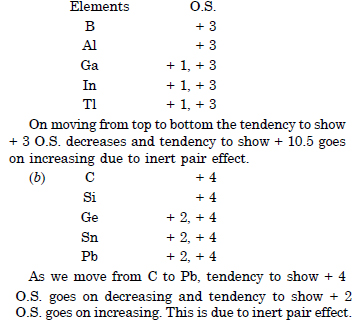
Question 35:
How can you explain higher stability of BCl3 as compared to TlCl3 ?
Answer:
This is due to inert pair effect. Inert pair effect is more in Tl and negligible in case of B.
Question 36:
Why does BF3 behave as Lewis acid ?
Answer:
BF3 behaves a Lewis acid because in BF3 the central boron atom has only six electrons in its valence shell after sharing with the electrons of the F atoms. It is an electron deficient compound and, therefore, behaves as a Lewis acid.
Question 37:
Consider the compounds BCl3 and CCl4. How will they behave towards water ?
Answer:
In BCl3 (B atom is sp2 hybridised), the B atom has incomplete octet and has an unhybridised 2p-orbital which can take up electron pair from the H2O molecule to form addition product.

This shows that boron trichloride has undergone hydrolysis. But this is not possible with carbon tetrachloride (CCl4). The carbon atom has a complete octet and has no vacant d-orbitals with valence shell and therefore CCl4 cannot be hydrolysed. When added to water, it even does not mix and forms a separate oily layer.
Question 38:
Is boric acid a proton acid ? Explain.
Answer:
Boric acid is not a proton acid. It is a Lewis acid and accepts electron pair from hydroxyl group of H2O molecule.

Question 39:
Explain what happens when boric acid is heated ?
Answer:

Question 40:

Answer:

Question 41:
Write reactions to justify amphoteric nature of aluminium.
Answer:
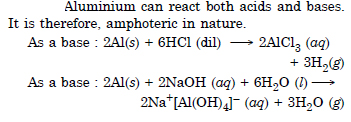
Question 42:
Write reactions to justify amphoteric nature of aluminium.
Answer:

Question 43:
What are electron deficient compounds ? Are BCl3 and SiCl4 electron deficient species ? Explain.
Answer:
Electron deficient compounds are the compounds in which the central atom in their molecule has a tendency to take up electron pairs. The electron deficient compounds are also called Lewis acids. Yes, both BCl3 and SiCl4 are electron deficient. Whereas B atom has a vacant 2p orbital atom at the same time Si has vacant 3d-orbitals. Both these atoms can take up electron pair from electrons donor species.
Question 44:

Answer:
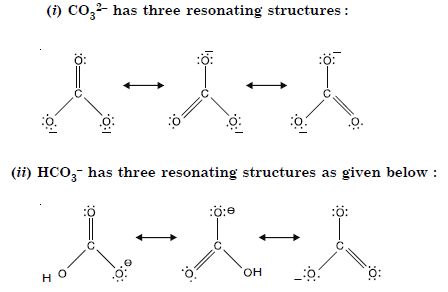
Question 45:

Answer:

Question 46:
Explain the difference in properties of diamond and graphite on basis of their structures.
Answer:
Refer to Additional Important Qs. (SAQs); Q. No. 42.
Question 47:
Rationalise the given statements and give chemical reaction :
(a) lead (II) chloride reacts with Cl2 to give PbCl4.
(b) lead (IV) chloride is highly unstable towards heat
(c) lead is known not to form an iodide, PbI4.
Answer:
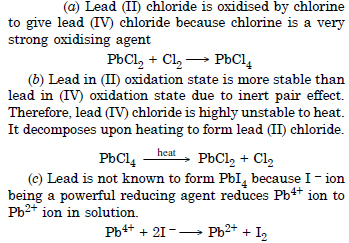
Question 50:

Answer:
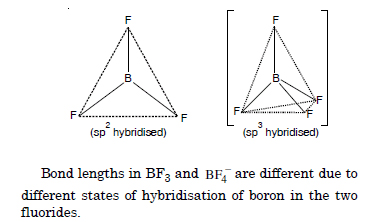
Question 51:
If B – Cl bond has a dipole moment, why does BCl3 have zero dipole moment ?
Answer:
B–Cl bond has a certain dipole moment because it is of polar nature. But BCl3 has zero dipole moment since the molecule is symmetrical (trigonal planar) in which net dipole moment is zero.
Question 52:
Aluminium trifluoride is insoluble in anhydrous HF but dissolves on addition of NaF. Aluminium trifluoride precipitates out of the resulting solution when gaseous BF3 is bubbled through. Give reasons.
Answer:

Question 53:
Suggest a reason as to why CO is poisonous in nature.
Answer:
Carbon monoxide is highly poisonous in nature. Its poisonous character is due to tendency to combine with haemoglobin present in blood to form carboxyhaemoglobin due to which haemoglobin is not in a position to carry the oxygen to different parts in the body. This will lead to suffocation and ultimately to death.
Question 54:
How is excess content of CO2 responsible for global warming ?
Answer:
Carbon dioxide (CO2) like methane has a tendency to absorb heat. It is known as a green house gas and its high concentration in the atmosphere is responsible for global warming.
Question 55:
Explain the structure of diborane and boric acid.
Answer:
Refer to Additional Important Qs. (SAQs); Q. No. 30.
Question 56:
What happens when
(a) Borax is heated strongly
(b) Boric acid is added to water
(c) Aluminium is treated with dilute Na
(d) BF3 is reacted with ammonia.
Answer:
(a) When powdered borax is heated strongly in the flame of bunsen burner, it forms colourless transparent glassy (glass-like) bead made of sodium meta borate and boric anhydride
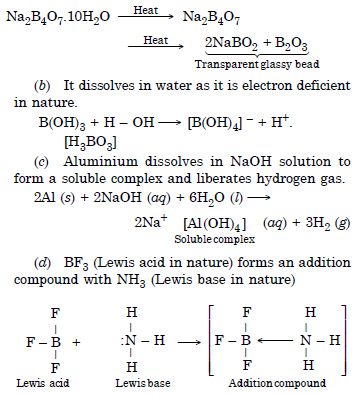
Question 57:
Explain the following reactions :
(a) Silicon is heated with methyl chloride at high temperature in the presence of copper.
(b) Silicon dioxide is treated with hydrogen fluoride
(c) CO is heated with ZnO
(d) Hydrated alumina is treated with aqueous NaOH solution.
Answer:
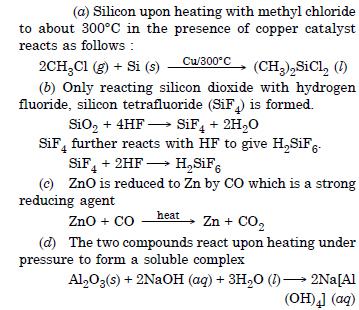
Question 58:
Give reasons :
(i) Conc. HNO3 can be transported in aluminium container.
(ii) Graphite is used as lubricant.
(iii) Diamond is used as an abrasive.
(iv) Aluminium alloys are used to make aircraft body.
(v) Aluminium utensils should not be kept in water overnight.
(vi) Aluminium wire is used to make transmission cables.
Answer:
(i) Conc. HNO3 initially reacts with aluminium to form aluminium oxide (Al2O3) which forms a thin protective coating inside the container. The metal becomes passive and does not further with the acid any more. Therefore, the acid can be safely stored in aluminium container.
(ii) Graphite is used as lubricant because of its soft and greasy nature. This is probably due to the presence of layers in the arrangement of carbon atoms in graphite which can readily slip over each other.
(iii) Diamond is used as an abrasive because of its extremely hard nature due to the pressure of strong C – C bonds.
(iv) Alloys of aluminium ; Magnalium and Duralumin both of which contain about 95% of the metal are used for making aircraft body because these are light and tough.
(v) Although the metal as such is not affected by water, but when kept overnight it may be slowly affected by moisture in the presence of oxygen (air.)
(vi) The metal is not affected by air and moisture and also because of its good conductivity, it is used to make transmission cables.
Question 59:
Explain why is there a phenomenal decrease in ionization enthalpy from carbon to silicon.
Answer:
On moving from B to Sn, the ionisation enthalpy decreases. But from Sn to Pb, there is a slight increase in ionization enthalpy due to poor shielding effect of intervening d and f-orbitals.
Question 60:
How would you explain the lower atomic radius of Ga as compared to Al ?
Answer:
Atomic radius of Ga is less than Al because of poor shielding by intervening 3d electrons.
Question 61:
What are allotropes ? Sketch the structure of two allotropes of carbon namely diamond and graphite. What is the impact of structure on physical properties of two allotropes ?
Answer:
Refer to Additional Important Qs.(SAQs); Q. No. 7.
Question 62:
Classify following oxides as neutral, acidic, basic or amphoteric :
CO, B2O3, SiO2, CO2, Al2O3, PbO2, Tl2O3.
Answer:

Question 63:
In some of the reactions thallium resembles aluminium, whereas in others it resembles with group I metals. Support this statement by giving some evidences.
Answer:
Aluminium (Al) generally exhibits +3 oxidation state in its compounds. Thallium (Tl), the last member of the group 13, is expected to show oxidation states of + 3 and + 1 (due to inert pair effect). Thus, the metals resemble in the reactions involving + 3 oxidation state. However, they differ with respect to + 1 oxidation state.
Question 64:
When metal X is treated with sodium hydroxide, a white precipitate (A) is obtained which is soluble in excess of NaOH to give soluble complex (B). Compound (A) is soluble in dilute HCl to form compound (C). The compound (A) when heated strongly gives (D) which is used to extract metal. Identify (X), (A), (B), (C) and (D). Write suitable equations to support their identities.
Answer:
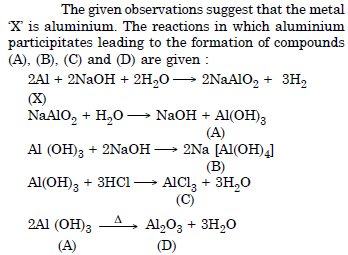
Question 65:
What do you understand by (a) inert pair effect (b) allotropy (c) catenation ?
Answer:
(a) Inert Pair effect. The reluctance of ns2 pair in p-block elements having higher atomic number
to take part in bond formation is called inert pair effect.
(b) Allotrops : The existence of an element in more than one form having different physical properties but same or slightly different properties is called allotropy.
(c) Catenation : The property by virtue of which a large number of atoms of the same element get linked together through covalent bonds resulting in the formation of long chains, branched chains and rings of different sizes is called catenation.
Question 66:
A certain salt X, gives the following results :
(i) Its aqueous solution is alkaline to litmus.
(ii) It swells up to a glassy material Y on strong heating.
(iii) When conc. H2SO4 is added to a hot solution of X, white crystal of an acid Z separates out.
Write equations for all the above reactions and identify X, Y and Z.
Answer:

Question 67:

Answer:
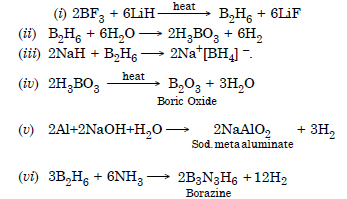
Question 68:
Give one method for industrial preparation and one for laboratory preparation of CO and CO2 each.
Answer:
Refer to Additional Important Qs.(LAQs); No. 13.
Question 69:
An aqueous solution of borax is
Answer:
(c).
Question 70:
Boric acid is polymeric due to
Answer:
(b).
Question 71:
The type of hybridisation of boron in diborane is
Answer:
(c).
Question 72:
Thermodynamically the most stable form of carbon is
Answer:
(b).
Question 73:
Elements of group 14
Answer:
(b).
Question 74:
If the starting material for the manufacture of silicones is RSiCl3, write the structure of the product formed.
Answer:
